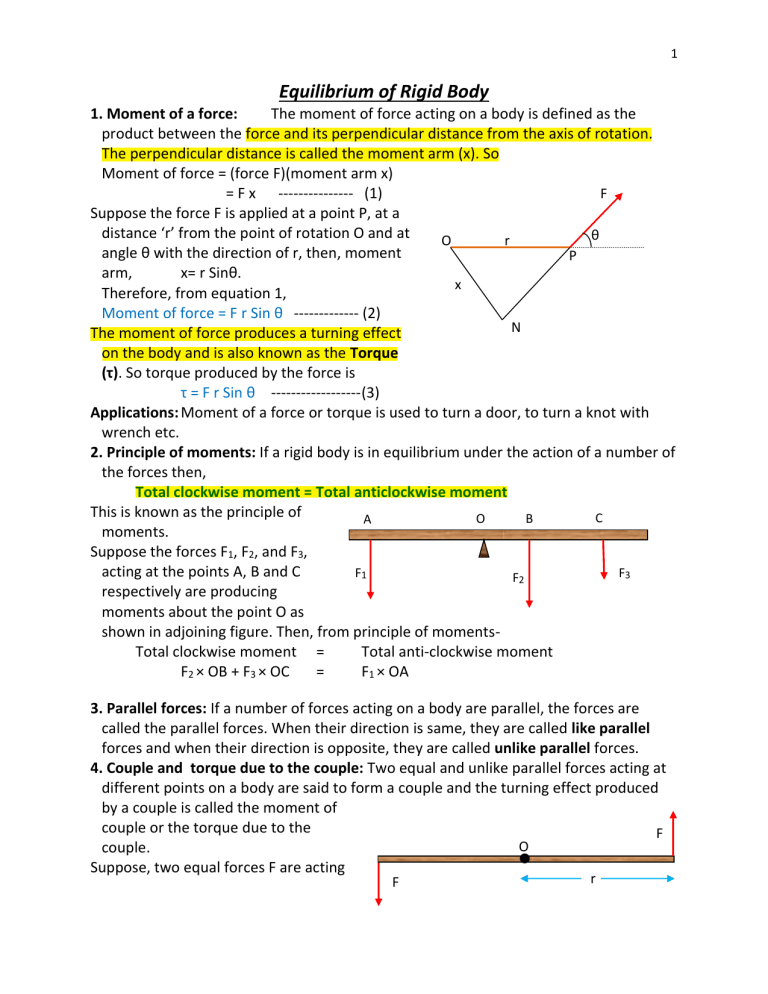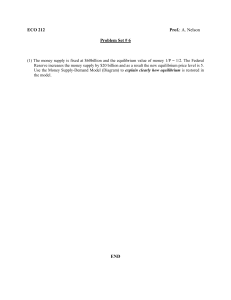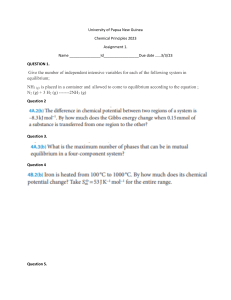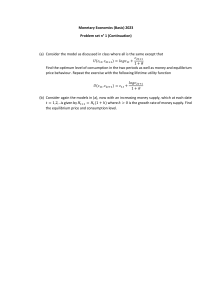
1 Equilibrium of Rigid Body 1. Moment of a force: The moment of force acting on a body is defined as the product between the force and its perpendicular distance from the axis of rotation. The perpendicular distance is called the moment arm (x). So Moment of force = (force F)(moment arm x) F = F x --------------- (1) Suppose the force F is applied at a point P, at a distance ‘r’ from the point of rotation O and at θ O r angle θ with the direction of r, then, moment P arm, x= r Sinθ. x Therefore, from equation 1, Moment of force = F r Sin θ ------------- (2) N The moment of force produces a turning effect on the body and is also known as the Torque (τ). So torque produced by the force is τ = F r Sin θ ------------------ (3) Applications: Moment of a force or torque is used to turn a door, to turn a knot with wrench etc. 2. Principle of moments: If a rigid body is in equilibrium under the action of a number of the forces then, Total clockwise moment = Total anticlockwise moment This is known as the principle of C O B A moments. Suppose the forces F1, F2, and F3, acting at the points A, B and C F1 F3 F2 respectively are producing moments about the point O as shown in adjoining figure. Then, from principle of momentsTotal clockwise moment = Total anti-clockwise moment F2 × OB + F3 × OC = F1 × OA 3. Parallel forces: If a number of forces acting on a body are parallel, the forces are called the parallel forces. When their direction is same, they are called like parallel forces and when their direction is opposite, they are called unlike parallel forces. 4. Couple and torque due to the couple: Two equal and unlike parallel forces acting at different points on a body are said to form a couple and the turning effect produced by a couple is called the moment of couple or the torque due to the F O couple. Suppose, two equal forces F are acting F r 2 In opposite direction at the distance r on either side from the axis of rotation O, as shown In figure. The torque produced about the point O is given by: Torque, τ = either force × perpendicular distance or, τ=Fr Examples- Torque produced by couple is used to turn the cap of bottle, turn steering wheel, turn a screwdriver, open or close a water tap, turn a key etc. 5. Center of Gravity (CG) A rigid body is composed of a large number of particles and the forces of gravity at each particle act parallel to each other. The point at which the resultant of the forces of gravity at each particle on the body acts is called the center of gravity of the body. So CG represents the point at m2 which the resultant weight of the body acts m1 irrespective of the position. When a body is CG m3 supported at its CG, it remains in the balanced m 2g position. m 3g m n For a body having regular geometrical shape, the CG lies m 1g at its geometrical center. mng W = Mg Center of Mass (CM) The center of mass of a rigid body or a system of particles is defined as the point at which the whole mass of the body may be supposed to be concentrated. When a force is applied on a body at its CM, the body is accelerated without rotation. Suppose a body is composed of n number of particles of masses m1, m2, m3,………….., mn,located at the positions (x1 , y1), (x2 , y2), (x3 , y3),…………….., (xn , yn) respectively, then the position of the center of mass- (x , y) is given by the formula: x= y= 𝑚1 𝑥1 +𝑚2 𝑥2 +𝑚3 𝑥3 +⋯………𝑚𝑛 𝑥𝑛 𝑚1 +𝑚2 +𝑚3 +⋯………+𝑚𝑛 𝑚1 𝑦1 +𝑚2 𝑦2 +𝑚3 𝑦3 +⋯………𝑚𝑛 𝑦𝑛 𝑚1 +𝑚2 +𝑚3 +⋯………+𝑚𝑛 = = ∑𝑛 𝑖=1 𝑚𝑖 𝑥𝑖 ∑𝑛 𝑖=1 𝑚𝑖 𝑛 ∑𝑖=1 𝑚𝑖 𝑦𝑖 ∑𝑛 𝑖=1 𝑚𝑖 The center of mass of two particle system having masses m1 and m2, satisfies the relation: m1 r1 = m2 r2, Where r1 and r2 are the distances of the particles from their common center of mass. Differences between Center of mass and Center of gravity: 3 CG CM i) It is the point where effective weight of the body acts on it. i) It is the point where total mass of the body is supposed to be concentrated. ii) CG exists only when the body is inside a gravitational field ii) CM exists in all conditions. iii) When a body is supported vertically below its CG, it remains balanced. iii) When an external force is applied along the line with CM, the body is translated without rotation iv) For the bodies of very large dimensions, position of CG changes slightly with its orientation. iv) Position of CM of a body does not change with its orientation. Equilibrium of rigid body A rigid body is said to be in equilibrium under the action of a number of forces if there is no acceleration of translation (i e, a=0) and no acceleration of rotation (ie α=0). So equilibrium are of following two types: a. Translational equilibrium A body will be in translational equilibrium when the net force acting on the body is zero, ie when net forceF = F1+ F2+…………..............+ Fn = 0 (i) Where F1, F2,…………………………., Fn are the forces acting on the body. In terms of the components, this condition can be written asF1x+ F2x+…………..............+ Fnx = 0 Or ∑ Fx = 0, and, F1y+ F2y+…………..............+ Fny = 0 Or (ii) (iii) ∑ Fy = 0 With net force zero, we have, acceleration a=0 or velocity v= constant. So a body can be in translational equilibrium either at rest or under uniform velocity. 4 b. Rotational equilibrium A body will be in rotational equilibrium when the vector sum of all the torques about any axis is zero, ie, when the net torqueτ = τ1 + τ2 +…………………+ τn = 0, (iv) This may be written as, Total clockwise torque = Total counterclockwise torque (v) With no net torque we have, angular acceleration α = 0, and angular velocity ω = 0. So a body will be in rotational equilibrium when it is at rest or rotating with constant angular velocity States of Equilibrium Stable, b. There are the three states of equilibrium: Unstable and c. Neutral a. A body is said to be in stable equilibrium if it can come back to its original position even after it is slightly tilted from the equilibrium position. This type of equilibrium is obtained when the base of the body is large and the CG lies low, as shown in fig (a) below. A body is said to be in unstable equilibrium if it cannot come back to its original position after it is slightly tilted from the equilibrium position. This type of equilibrium is obtained when the base of the body is small and the CG lies high, as shown in fig (b) below. A body is said to be in neutral equilibrium if it cannot return back to the original equilibrium position, but comes to new equilibrium position which is similar to the previous position. Here the position of the CG always remains in the same height as shown in fig (c) below. c Conceptual questions b a 1. Handle of a door is provided near the outer edge of the plank, why? 2. A wrench of long arm is preferred to unscrew a tight knot, why? 5 3. What are the differences between the CG and CM? 4. Is it possible that the center of mass of a body to lie at a point where there is no mass? Explain with examples 5. How is a cow more stable than a standing man? 6. Why a person carrying a load with one hand leans to the opposite side? 7. A porter carrying a load on his back leans forward, why? 8. It is difficult to hold a 10 kg mass with your arms extended horizontally than with the mass close to your side, why? 9. Pregnant women often complain of back pain. What could be the physical cause behind it? 10.Can a body be in equilibrium while in motion? 11.Heavy load is placed at the base of cart while loading it. Why? 12.Does the center of mass always coincide with its center of gravity? 13.Does the center of gravity of a body always lie within the body? If not, give examples 14.Why does a table fan have a large and heavy base? Numerical Examples: 1. 1. A roller of diameter 1 m has its weight 360N. What horizontal force is necessary to pull the roller over a brick 0.1 m high when the force is applied at the center? Here, C is the point of rotation. Radius, OC = ½= 0.5 m BC = OA = 0.5 - 0.1 = 0.4m F=? B O AC = OC2 − OA2 = 0.52 − 0.42 = 0.3 m In order to just pull the roller over the brick, A Moment of force F about C = Moment of weight about C C 0.1m Or, F × BC = W × AC Or, F × 0.4 = 360 × 0.3 W = 360N Or, F = 270 N 6 Example 2 1. A rectangular plate ABCD has two forces of 100 N acting along AB and DC in opposite directions. If AB = 3m , BC = 5m, what is the moment of couple (torque) acting on the plate? What forces acting along BC and AD respectively are required to keep the plate in equilibrium? F’= ? Here, clockwise torque due to F = 100N force, τcw = either force × perpendicular distance = F×BC A =100×5 = 500Nm Again to keep the plate in equilibrium required anticlockwise torque F=100N 3m B 5m τacw = either force × perpendicular distance = F’×3 At equilibrium, F=100N D C τacw = τcw F’×3 = 500 F’ = 166.7 N F’ 1. The foot of a uniform ladder is on a rough horizontal ground, and the top rests against a smooth vertical wall. The weight of the ladder is 400 N and a man weighing 800 N stands on the ladder one-quarter of its length from the bottom. If the inclination of the ladder to the horizontal is 30o, find the reaction at the wall and Y the total force at the ground. Y’ E R Here, AB = L, is the length of ladder. B X’ Blue arrows represent the different forces, whereWl = 400 N at D, C Wp = 800 N at C F R = ?, the reaction of wall D directed horizontally θ 30o F = ?, which is the reaction of the O X A total force on groud, which is Wp= 800N Wl= 400N directed at angle θ with ground Since the ladder is in rotational equilibrium about the point A, we writeTotal clockwise torque about A = Total anticlockwise torque about A Wp × AD Cos 30o + Wl × AC Cos 30o = R × AB Sin 30o (Torque = force × force arm) 800 × L/4 × 3 /2+ 400 × L/2 × 3 /2 = R × L × 1/2 Giving, R = 692.8 N 7 Again, ladder is in translational equilibrium, (∑ F𝑦 =0) Net upward force on ladder = net downward force FSinθ = 400 + 800 = 1200N -----------------------------(1) And, (∑ F𝑥 =0) Net force to right = net force to left F Cosθ = R = 692.8 N --------------------------------------(2) Squaring and adding equations 1 and 2 we getF = 1385.64 N Mass of square, m2 = 400 × m The centres of mass lie at the geometrical centres. So, Position of centre of mass of triangle, x1 = 2/3 of OE = 2/3 × 17.32 = 11.55 cm from O Position of centre of mass of square, x2 = OE + EQ = 17.32 + 10 = 27.32 cm Therefore by formula, the position of CM of the plate is given byX= 𝑚 1 𝑥 1 +𝑚 2 𝑥 2 𝑚 1 +𝑚 2 = 173.2m ×11.55+400m ×27.32 173.2m +400m = 22.53 cm from O 1. A flat plate is cut in the shape of a square of side 20.0 cm with an equilateral triangle of side 20.0 cm adjecent to the square. Calculate the distance of the centre of mass from the apex of Y the triangle. Here OABCD is the plate, and D C The apex of triangle is at the origin O. For triangle, O E P Q F OA = AD = DO = 20.0 cm OE = OA2 − AE2 = 202 − 102 = 17.32 m Area, A1 = 1/2 × AD × OE = ½ × 20 × 17.32 = 173.2 cm2 Again, area of the square ABCD, A2 = 20 × 20 = 400 cm2 Now if mass per unit area of the plate is m, then Mass of triangle, m1 = 173.2 × m A B X 8 Mass of square, m2 = 400 × m The centres of mass lie at the geometrical centres. So, Position of centre of mass of triangle, x1 = 2/3 of OE = 2/3 × 17.32 = 11.55 cm from O Position of centre of mass of square, x2 = OE + EQ = 17.32 + 10 = 27.32 cm Therefore by formula, the position of CM of the plate is given byX= 𝑚 1 𝑥 1 +𝑚 2 𝑥 2 𝑚 1 +𝑚 2 = 173.2m ×11.55+400m ×27.32 = 22.53 cm from O 173.2m +400m 9 1. A trap door 120 cm by 120 cm is kept horizontal by a string attached to the midpoint of the side opposite to that containing the hinge. The other end of the string is tied to a point 90 cm vertically above the hinge. If the trap door weigh is 50 N, calculate the tension in the string and the reaction at the hinge. In figure, AB is trap door, with hinge at B and AB = 120 cm. E AE is the string with BE = 90 cm. Blue arrows are the forces, where T is tension at D 90 cm string, R is reaction at the hinge and W is the T weight. R θ The weight W acts vertically downward from the θ C A B midpoint C of door. Since the door is in equilibrium 60 cm 60 cm under the action of three forces- T, R and W, they W = 50 N all meet at the same point D. Therefore DC (along which W acts) must be the perpendicular bisector of the triangle ABD such that AD = BD. So we write- angle DAB = angle DBA = θ. In rt. Triangle ABE, AE = AB2 + BE2 = 1202 + 902 = 150 cm Sinθ = 90 Alternatively, use- 150 direction, Now for translational equilibrium along horizontal TCosθ = RCosθ or, T=R Again, for rotational equilibrium about the point B, W × BC = T Sinθ × BA or, Thus, T= W × BC Sin θ × BA T = R =41.7 N 50×60 = 90 150 ×120 = 41.7 N T Cosθ + R Cosθ = W (for translational equilibrium in vertical direction) or, 2 TSinθ = W or, T= 10 1. A wireless aerial attached to the top of a mast 20m high exerts a horizontal force upon it of 600 N. The mast is supported by a stay wire running to the ground from a point 6m below the top of the mast and inclined at 60o to the horizontal. Assuming that the action of the ground on the mast can be regarded as a single force, determine the tension in the stay wire. Hints: Clockwise moment of 600N force F= 600 = Anticlockwise moment of T about point A C N 6m B 20 m T Stay wire 60o D A





